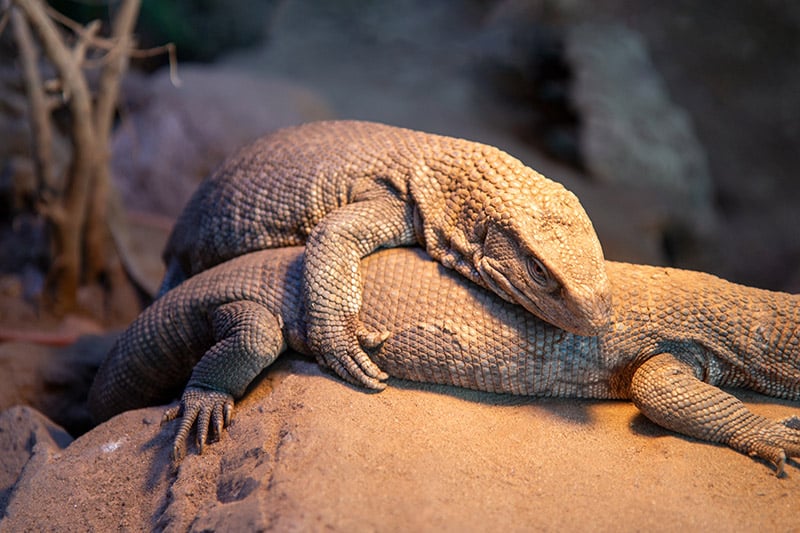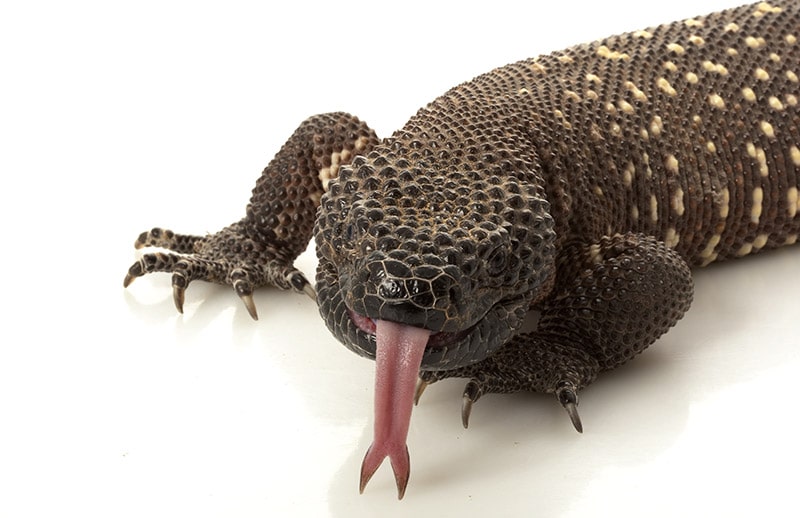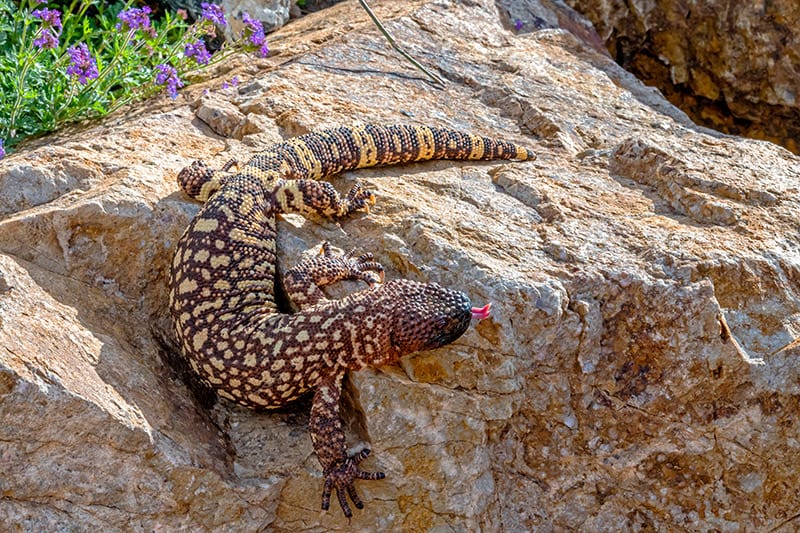The amazing Mexican Beaded Lizards are quite unique among the reptiles!
The Beaded Lizard Heloderma horridum is a spectacle to behold. The size and sheer beauty of this lizard are more than enough to make any intermediate to experienced herp keeper fascinated. Though it is a venomous reptile and its scientific name means “horrible studded lizard”, it is a true showpiece.
The Mexican Beaded Lizard is one of two species of venomous lizards in the family Helodermatidae. Both species are similar in appearance and habits, but its cousin, the Gila Monster Heloderma suspectum, is slightly smaller and more colorful.
No other lizards have been have been so immersed in myth and mystery as these two Helodermatidae lizards. Possibly because of their rather secretive lifestyles. They spend a good deal of their time in their burrows and their habitats are very remote.
- CAUTION: These are VENOMOUS LIZARDS. In many areas, these lizards may only be kept with a license. The keeping of venomous reptiles is restricted and/or regulated in many localities. Check with your state and city authorities for requirements.
Other factors that make the Beaded Lizard and the Gila Monster so mysterious could be that they are poisonous lizards, as well as being the sole survivors of an ancient group of lizards, the Monstersauria. They have been two of the least understood and least studied of the lizard species, though they have been regularly kept by herp enthusiasts for several decades.
Mexican Beaded Lizards do not make good “pets”. But for a serious herp enthusiast, their habits and environment requirements make them ideally suited for captivity and visual enjoyment. Despite their size, they don’t require a lot of area for activity, and they are relatively easy to keep.
Do exercise caution when handling this lizard. Both species of Heloderma are sluggish in habit, but they have a strong, tenacious bite…with a ‘bulldog’ attitude of not wanting to readily let go.
The beaded lizards are beautiful animals, and the Mexican Beaded Lizard can be very enjoyable to the experienced herp keeper. They require permits to be owned in many states, and in some states, while the state may not have a law, the city may have regulations regarding these animals.
Scientific Name: Heloderma horridum means “horrible studded lizard”!
What’s in a name? | ||
|---|---|---|
| Heloderana | means | “studded skin” |
| horridum | means | “horrible |
- For more information on keeping lizards see: Reptile Care: Keeping Reptiles and Amphibians as Pets
Scientific Classification
| Kingdom: | Animalia |
| Phylum: | Chordata |
| Class: | Reptilia |
| Order: | Squamata |
| Family: | Helodermatidae |
| Genus: | Heloderma |
| Species: | horridum |
Scientific Name
- Mexican Beaded Lizard Heloderma horridum horridum
- Black Beaded Lizard Heloderma horridum alvarezi
- Rio Fuerte Beaded Lizard Heloderma horridum exasperatum
- Montagua Valley Beaded Lizard Heloderma horridum charlesbogerti

Habitat: Distribution/Background
The Beaded Lizard Heloderma horridum was first described by Wiegmann in 1829. Mexican Beaded Lizards are found throughout central and western Mexico from latitude 25 southward to northern Central America. They inhabit thorn scrub and pine forests, as well as tropical forest. They spend a vast majority of their time in their dens or burrows.
There are four subspecies of Beaded Lizard, found in the following ranges:
- Mexican Beaded Lizard Heloderma h. horridum, the nominate Beaded Lizard subspecies, are found in Mexico, from Sonora to Oaxaca.
- Black Beaded Lizard Heloderma h. alvarezi, described by Bogert and Martin del Campo in 1956, are found in the in the northern Chiapas regions of Mexico to northwestern Guatemala.
- Rio Fuerte Beaded Lizard Heloderma h. exasperatum, also described by Bogert and Martin del Campo in 1956, are found in Mexico from southern Sonora to northern Sinaloa.
- Montagua Valley Beaded Lizard Heloderma h. charlesbogerti, described by Campbell and Vannini in 1988, are found in the north-east of Guatemala.
The regions of the first three of these Beaded Lizards overlap and thus they regularly encounter one another while the Montagua Valley Beaded Lizard is isolated from the other three species. Only two if these subspecies, the Mexican Beaded Lizard Heloderma h. horridum and the Rio Fuerte Beaded Lizard Heloderma h. exasperatum are bred in private collections in the United States. The Montagua Valley Beaded Lizard Heloderma h. charlesbogerti has been bred by the San Diego Zoo.
Status
The Heloderma suspectum is on the IUCN Red List for Endangered Species as Least Concern (LC). The general status of these lizards is relatively staple because three of the subspecies are widely distributed with overlapping ranges, and they are often in protected areas. One subspecies however, the Montagua Valley Beaded Lizard Heloderma h. charlesbogerti, is isolated from the others and in a very limited range. Its population is severely limited, current estimates are only around 200 species in the wild, and it is possibly one of the most highly endangered lizards.
Description
The Mexican Beaded Lizards, true to their name, have black “beaded” scales with either a yellow or white pattern to them. They have squat, fat tails that store fat reserves. Their forked tongue is serpentine in nature and flicks in and out to smell, much like a snake.
They closely resemble the Gila Monster in many ways, except for being larger and darker colored. The venom glands are in their lower jaws, and the venom leeches out from the glands and flows through the grooves in the teeth of the lower jaw and is delivered by a chewing motion. These lizards use venom primarily as a defensive weapon.
These beautiful lizards can grow to be up to3′ (91 cm) in length and weigh around three and a half to five pounds, the females are slightly smaller. The largest males have been known to get to 40″ (101 cm) and weigh close to ten pounds. They have a long life span, living 30 to possibly 50 plus years.

Food and Feeding
In the wild, the Mexican Beaded Lizard eats mostly the eggs of reptiles and birds, and occasionally small animals. In captivity Mexican Beaded lizards will eat commercially available foods, pinkies, mice, and small rats when they are adults.
While eggs are a natural food source in the wild, these should be avoided in captivity for a few reasons. The salmonella in eggs can be transferred to your lizard. Also, egg foods tends to be fattier. This is only acceptable for lizards in the wild, as they must store food reserves in their tail to make it through when there is no food available. In captivity this can lead to obesity.
Housing
Adult Mexican Beaded Lizards should be maintained with a minimum of 3 ½ square feet of floor space. Grape vine or other materials may be provided so that they can climb. Substrate can be anything from newspaper to wood shavings, with Aspen shavings being the best. These are easy to clean out and replace and work well with the lizards. Because this is a venomous lizard, be sure that the lizard is kept in an enclosure that has a lid to prevent its escape.
While they are a desert lizard, they need more humidity than most desert animals. They need a large water bowl that they cannot knock over, preferably large enough for them to soak in if they so desire.
Temperature and Lighting requirements:
These lizards like the temperatures in the low seventies on the cool side of their cage to the high eighties on the warm side. A basking area can be as simple as an elevated rock and placed under the basking light. Heating for the basking area can be provided by a clamp lamp and a bulb with wattage appropriate to the size enclosure the lizard is in.
Cage Care
Cage maintenance is an important part of keeping reptiles healthy, and long-lived. Reptiles being kept in a confined area as pets need to be protected from harmful micro-organisms and parasites. The reptile cage needs daily and weekly maintenance.
Spot cleaning should be performed on a daily basis, or at least following meals. If they are allowed to soak for long periods of time every day in the water bowl, it will need daily cleaning. Any liquid spills should be cleaned up immediately, with the damp litter being removed.
Everything you put into their home should be washed and disinfected weekly. This includes dishes and cage decor. All of the substrate should be replaced every one to two months, depending on the age of the lizard, and how often its feedings are. Never clean with a phenol such as Pine Sol. Chlorine and alcohol based cleaners are tolerated much better, but need to be thoroughly rinsed.
Behavior
In the wild, Beaded Lizards have a solitary nature. Lizards do not need companionship, and naturally view another lizard as competition for food and territory, and male lizards will compete for females. These lizards can be kept with success in groups, it they are given enough room. But keeping them in solitary enclosures better replicates their natural environment.

Handling
These lizards should only be handled by trained professionals. A thick pair of leather gloves may be used to offer some protection from these lizards. While many of the adults can be docile, it could take a single person or thing to startle the lizard to incur a bite. These are not tame animals.
NOTE: If you are bitten by a Beaded Lizard, seek medical attention immediately!
Reproduction
Most Mexican Beaded Lizards reach sexual maturity at about 2 1/2 to 3 years. Adult males are larger than females and generally have broader heads and longer necks.
In the wild, the male would scent out the female in the late spring. In captivity they have been observed to copulate in May and June. The female then lays her eggs in July and August. The incubation period is about 165 to 215 days, with the eggs hatching the following January to February.
When ready to lay, the female may show some swelling around the rear legs. She should be removed to a private enclose to lay her eggs, as other cage mates will eat them. Provider her with a large nesting box, or put her in an aquarium filled about 3/4 of the way with sphagnum moss for her to burrow down to the bottom of to lay her eggs. She can take up to 24 hours to lay. Vermiculite can be used as an incubation medium, keeping the temperature at about 79{deg} F (26{deg} C).
Neonate care in the Mexican Beaded Lizard is quite simple. They should be allowed to exit the egg on their own, even if it takes them a few days to do so. They will not eat for their first few days out of the egg, and up to a week. At a week of age, they should be taking pinkie mice. The temperature range for neonate care is from 78 – 88{deg} F (26 – 31 {deg} C) degrees.
Diseases: Ailments/Treatments
The biggest problem with Mexican Beaded Lizards is obesity, due to their extremely low metabolism. Take good care to only feed as much as is necessary.
Availability:
Mexican Beaded Lizards can be purchased from specialty breeders via the internet.
Note: Before attempting to find a breeder or other source for your Mexican Beaded Lizard, you need to check the laws of both your state and your city for the regulations in your area.
Featured Image Credit: Richard G Smith, Shutterstock
